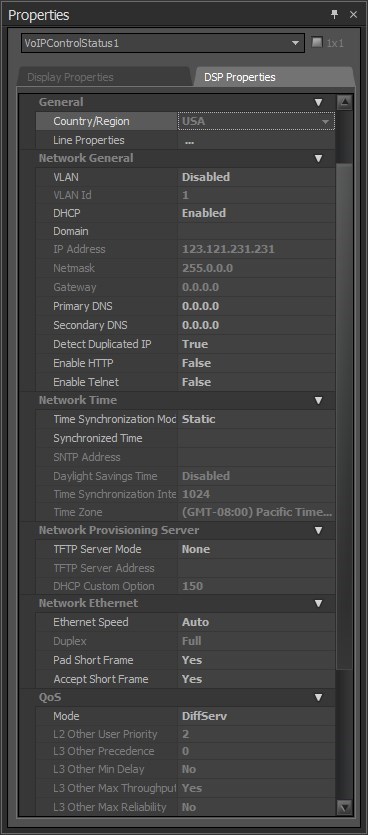VoIP Property Sheet
In the DSP Properties tab of the Properties window of the VoIP Control/Status block, there are additional settings which are global for the VoIP Phone card.

General
Country - Allows you to specify the country the VoIP phone is operating in.
Line Properties - Opens the VoIP Line Properties dialog to allow per line configuration fo the VoIP card. Some of the settings in this dialog are only available if enabled via the Property sheet.
Network General
VLAN and VLAN Id - When enabled, the VoIP card will only respond to and transmit to packets tagged with this VLAN ID number. VLAN's can also be configured by switch port. This option should only be enabled if requested by the network administrator.
DHCP / IP & Network Address - If DHCP is enabled, the DHCP server should provide the IP Address, Subnet Mask, Gateway and Primary/Secondary DNS.
Domain - This setting specifies the search domain for DNS names. For example, if the domain is set to "example.com" and the proxy is set to "voip", the result would be "voip.example.com". This setting is only enabled when DHCP is not being used; otherwise the DHCP server can provide the domain details.
Detect Duplicated IP - If DHCP is enabled on the SVC-2 and a device is added to the network with the same IP, the conflict will be reported in the Event Logs and the card restarted to request a new IP. If a static IP address is being used for the SVC-2 card, the conflict will be reported in the Event Logs too, but the card may remain in a conflicted fault state until being restarted manually.
Enable HTTP - This will enable HTTP access for the VoIP interface (port 80). Once enabled, a VoIP webpage is accessible at the IP address of the SVC-2 card over the network. This will allow VoIP to be configured over the network. This setting may be disabled if network security is an issue. For more information see the VoIP Webhelp located here.
Enable HTTPS - Enable HTTPS - This will enable HTTP access for the VoIP interface (port 443). Once enabled, a VoIP webpage is accessible at the IP address of the SVC-2 card over the network. This will allow VoIP to be configured over the network. This setting may be disabled if network security is an issue. For more information see the VoIP Webhelp located here.
Enable Telnet - This will enable Telnet connections to the VoIP interface (port 23). This is an engineering diagnostic interface only. For installations with security concerns about this port being open it should be disabled. There is no end user configurable settings in the engineering diagnostic interface and is password protected.
Note on HTTP/HTTPS webpage access: a configuration with HTTP or HTTPS enabled will be accessible over the network by entering https://xxx.xxx.xxx.xxx (Tesira VoIP's IP address), https://abc (hostname), or https://abc.xyz.com (FQDN).
Login credentials by default are:
- Username: admin
- Password: admin
Network Time
Time Synchronization Mode - If Simple Network Time Protocol (SNTP) is selected the IP address of the SNTP Server is required in the SNTP Address field for automatic network time synchronization. If SNTP is used the Time syncronization interval and timezone can also be specified. The current VoIP Card time can be seen in the VoIP Control/Status > Statistics Tab when Online.
If Static is set a value should be entered in the Synchronized Time
If Host is selected the VoIP card time will be synchronized to the host server devices time.
Network Provisioning Server
TFTP Server Mode, TFTP Server Address and DHCP Custom Option can be set.
Network Ethernet
Settings for speed and duplex properties of the VoIP Phone card.
QoS
QoS Mode - Selects the Quality of Service mechanism, TOS or DiffServ.
Diffserv:
- L2 Other User Priority - Sets the priority of VLAN tagged frames. 0-3 is low priority, 4-7 is high priority.
- Other DiffServ - Specifies how QoS is to be handled to and from other DiffServ capable domains.
TOS
- L3 Other Precedence - The Layer 3 Other Precedence uses 8 levels of priority, numbered 0-7, with 0 being the lowest priority and 7 the highest for managing the priority of all traffic, other than SIP and RTP data packets.
- L3 Other Min Delay - All traffic, other than SIP and RTP data packets to be forwarded with minimum delay.
- L3 Max Throughput - All traffic, other than SIP and RTP data packets to be forwarded with maximum throughput.
- L3 Max Reliability - All traffic, other than SIP and RTP data packets to be forwarded with maximum reliability.
- L3 Min Cost - All traffic, other than SIP and RTP data packets to be forwarded with minimum cost to network bandwidth.
Protocol SIP
Transport can be set to UDP, TCP or TLS.
Protocol SIPS
Is available if TLS is specified in the Protocol SIP section. Certificate Preference can be set to Fully Verify, Trust, Keyword, or Accept All.
Root Certificate File Name, Customized Certificate File Name, Certificate File Name and Private Key File Name can be specified.